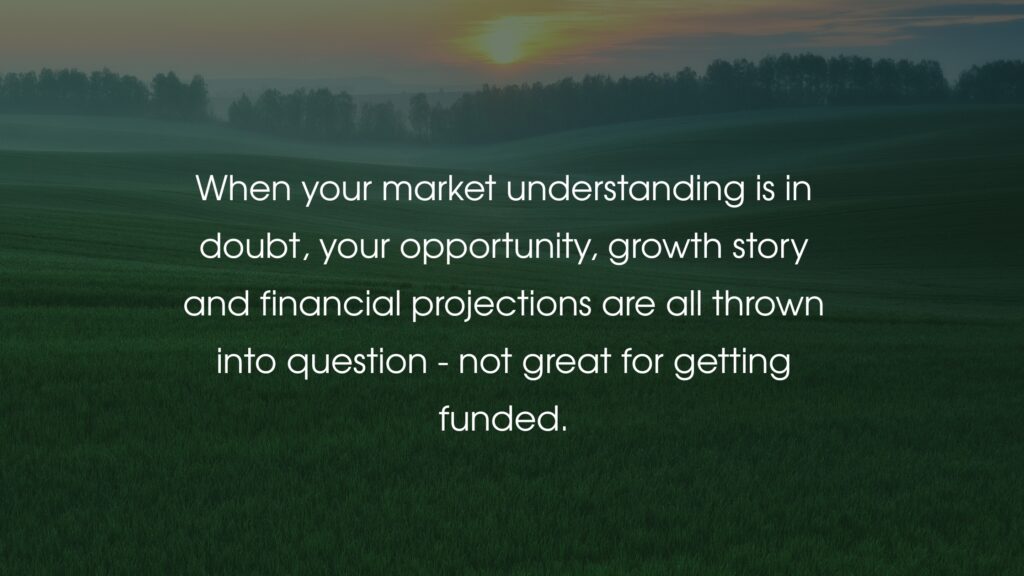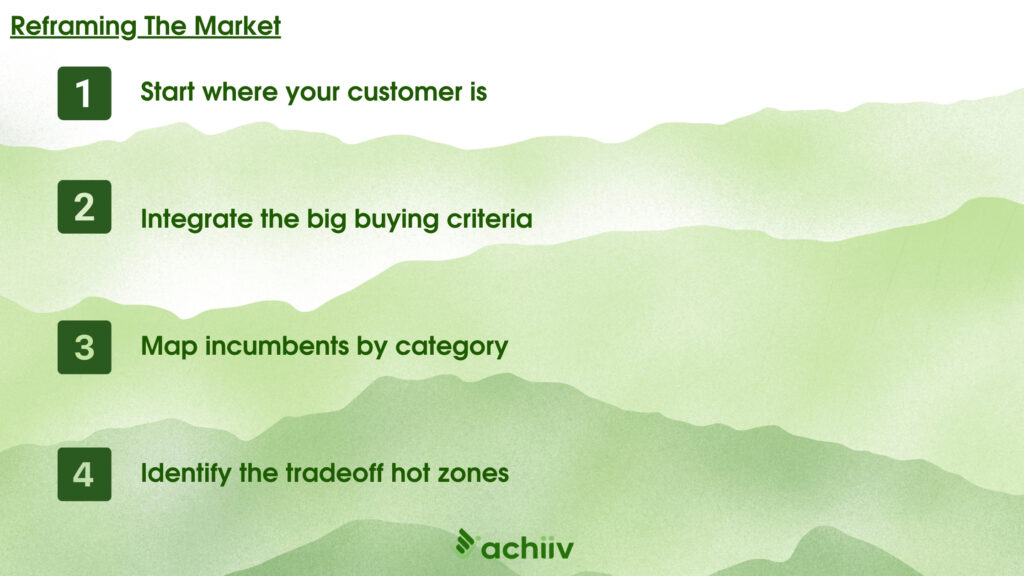There’s one thing about your pitch that frustrates investors more than almost anything else: a poor understanding of your market and competition. The surest sign of this is a pitch deck showing your product as unequivocally the “best” in the market.
When you focus too much on being the “best” product on many dimensions, you’re displaying your naïveté about how customers actually behave. Rational customers understand that they have to make tradeoffs when buying (e.g., price vs. level of support). Showing your product winning on all dimensions fails to address these important tradeoffs.
That’s not all. It also sparks serious doubt about whether you really know your market. When your market understanding is in doubt, your opportunity, growth story and financial projections will also get thrown into question – not good for getting funded.
Investors want to see a realistic perspective on a winnable market, and deep understanding of hidden competitors, especially the status quo. Your perspective on the competition is your vehicle to credibly communicate market mastery.
Red Flags That Signal Poor Market Understanding
When you talk about your competition, a few signs immediately raise red flags about your true market potential:
A Narrow Competitor List
There’s an old joke I read about NASA looking for a pen that would work in deep space. After spending a lot of time and money, they finally devised one that worked. When they asked the Russians how they solved the problem, the Russians shrugged and said, “Oh, we just used a pencil”.
This is a classic problem in deep tech. The founder is so steeped in their technology that they fail to see competing solutions to the same problem that have nothing to do with their field. This typically shows up in an overly narrow competitor list focused only on their approach to the problem – different kinds of space-ready pens, as in the NASA example, but no pencils.
If you’re defining the market through the lens of your innovation, rather than through what needs to be accomplished, you’ll vastly underestimate the real competition. This means you’ll overestimate the size of the winnable market, your revenue upside, and also underestimate the effort it takes to change the status quo.

Highly Technical Competitive Dimensions
Here’s another “tell” that signals a big market framing problem: technical features touted as competitive advantages. When I see words like “polymer architecture, ”thermal uniformity” or “coherence time” featured on the competitor slide, I know the startup has a long way to go in understanding their market.
These startups often overlook obvious competitors that investors can find with a quick Google search, something many investors do in real time during the pitch. When you’re blindsided by competitors who don’t use your specific technological approach, investors will take a hard pass.
No “Losing” Attributes
If a market is really attractive, there will be many competitors, but there’s always room for a unique solution. The real question then is what’s different, new or better about yours.
Here’s an example from a startup I worked with.
It’s in a different space, but I’ll use a parallel example that maps closely to what actually happened. Let’s say the startup sells an AI-powered donor targeting tool for nonprofits. The founders were very passionate about improving low yield from donor outreach.
They’d created a solution 10X better than anything else currently available, and customers agreed enthusiastically! So their competition slide showed how they outperformed traditional CRMs and email tools on personalization, timing, and predictive analytics.
The team had focused on what they cared about, i.e. targeting, and missed the fact that it was only a part of the tasks nonprofits had to do to successfully raise, like following up on responses, following through on pledges, etc.
Investors were skeptical of the glowing competitive comparison.
So the team zoomed out to the full fundraising stack that clearly showed where their tool added unique value by automating one key, time-consuming slice of the process. They were transparent about where they didn’t compete, and emphasized how their product could easily integrate with existing tools like Salesforce, rather than trying to replace them.
That reframing changed the game. Investors now saw that the tool in context made a strong case for credible market entry and strong potential for partnerships instead of yet another SaaS tool being touted as the best thing since sliced bread.
Keys to Signal True Market Understanding
The common factor amongst these red flags is a mismatch between how the founder sees the market and how the customer experiences it. The astute founder frames her competitive stance to align most closely with the customer view, versus projecting her product-oriented slant on the market.
There are three tools you can use to re-align your competitive landscape with your market.

Map to The Real Starting Line
If your product’s superiority is rooted in technological advances, it’s tempting to frame your competition in terms of others using similar technologies. Instead, shift to the customer’s chair. Start what’s already familiar to them, readily available and “good enough”.
Map actual alternatives they use when faced with the problem you’re solving. That includes spreadsheets, legacy equipment, contract vendors, or even doing nothing. Build from there to address the biggest headaches you solve that are making their lives miserable today.
For example, if you’re an AI pathology startup, compare yourself to legacy lab solutions bundled with procurement and billing. Then show how you maintain comparable ease of integration or billing compatibility while offering vastly superior diagnostic accuracy.
Align To the Buyer’s Scorecard
You can fast-track your way to a great competitor comparison by replicating the purchase criteria of your target customer on your slide, in the same order they use to make purchase decisions. This way, you’ll clearly highlight the real tradeoffs they need to make and position your product as the more attractive choice only for your customers, not the entire market.
For example, a startup making compact lab automation tools might highlight AI workflow features and high capacity. But their beachhead market cares most about training time and footprint, even at the cost of processing speed and capacity.
Their competitor comparison will be much more impactful if they showcase their product’s superiority only on the attributes their core customers care about. Their credibility will be higher if they’re also transparent that they can’t win on speed for the big labs, which isn’t their market anyway.
Signal Strategy, Not Superiority
Another strategy is to use competitive positioning to provide clarity rather than superiority. Instead of showing a laundry list of attributes to compare against, show a completely different way to view the market, and why that opens up a new opportunity for your startup.
Say you’re building a workflow automation software that’s faster, more secure and more customizable than existing solutions like Zapier or ServiceNow, for example. The lazy way to show this is the standard checklist method that shows your startup being “better” on all three attributes.
Expected. But BORING!
Instead, say you narrow your market to financial services firms, and reframe the competitive landscape based on only two key attributes:
- Level of compliance and regulatory needs (low to high)
- Appetite or budget for complex IT systems (low to high)
Voila! A gap opens up because today there’s no solution for companies with high compliance needs (e.g., wealth managers and small fintech firms) but no big IT budget.
This strategic reframe allows you to open up and own a whole segment that was clearly underserved. It leaves investors in no doubt about who you will and won’t compete against, and why you’ll win.
How To Make It Work For You
Competitor framing doesn’t have to be an ivory tower exercise. Start where you are with the accumulated market interactions you’ve already had, and sharpen the picture as you go along.
- Define the starting point: Start with where the customer is today, with the status quo solution, in-house hacks, and default behaviors as part of your competitive landscape.
- Integrate the buying criteria in the order the customers use to buy – don’t ask them directly, tease it out by recounting past purchase choices.
- Add incumbents by category, rather than by name, and rate them against what customers consider to be important. This will also give you insight into how they might view a “new-to-world” solution like yours. For example, new factory maintenance solutions can be compared with manual tools, spreadsheets, ERP bolt-ons on ease of use, mobile access, and setup time.
- Identify hard tradeoff zones: Look for areas of need where existing solutions force painful tradeoffs that your product could eliminate.
What new insights do you now have to make investors sit up and take notice?







